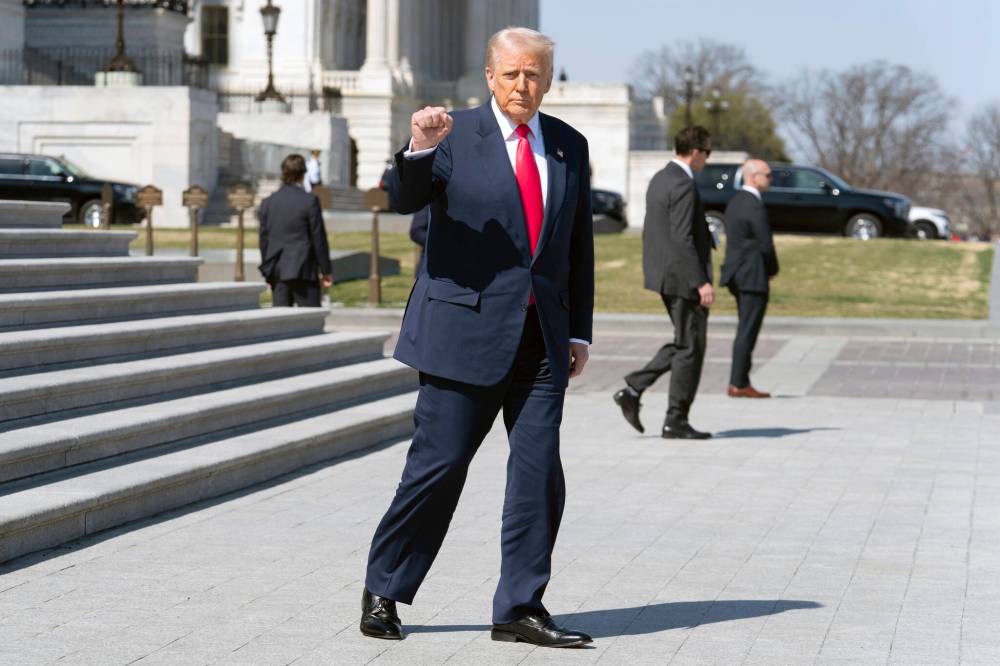Chaos follows Trump’s ‘Liberation Day’
Advertisement
Read this article for free:
or
Already have an account? Log in here »
To continue reading, please subscribe:
Monthly Digital Subscription
$0 for the first 4 weeks*
- Enjoy unlimited reading on winnipegfreepress.com
- Read the E-Edition, our digital replica newspaper
- Access News Break, our award-winning app
- Play interactive puzzles
*No charge for 4 weeks then price increases to the regular rate of $19.00 plus GST every four weeks. Offer available to new and qualified returning subscribers only. Cancel any time.
Monthly Digital Subscription
$4.75/week*
- Enjoy unlimited reading on winnipegfreepress.com
- Read the E-Edition, our digital replica newspaper
- Access News Break, our award-winning app
- Play interactive puzzles
*Billed as $19 plus GST every four weeks. Cancel any time.
To continue reading, please subscribe:
Add Free Press access to your Brandon Sun subscription for only an additional
$1 for the first 4 weeks*
*Your next subscription payment will increase by $1.00 and you will be charged $16.99 plus GST for four weeks. After four weeks, your payment will increase to $23.99 plus GST every four weeks.
Read unlimited articles for free today:
or
Already have an account? Log in here »
Hey there, time traveller!
This article was published 05/04/2025 (266 days ago), so information in it may no longer be current.
Sometimes, condensing events into something as short as an editorial can be dizzyingly difficult.
Take, say, U.S. President Donald Trump’s Wednesday.
This week saw a near-global imposition of tariffs by Trump, followed by plunging financial markets, with global stock exchanges plummeting overnight after Trump’s announcement. He called it “Liberation Day,” claiming that jobs and manufacturing would stream back to the United States, but a better description would be “Chaos Day,” as countries scrambled to determine what havoc had been wrought on their economies, and on the global economy as a whole.

Canada did not face new tariffs in this round — but that’s not really a success. The already-announced across-the-board 25 per cent tariff on most Canadian goods, the 10 per cent tariff on energy, and the tariffs on Canadian steel and aluminum are harm enough.
Lost in it all is the concept of trade deficits — something that Trump brings up endlessly.
Trump claims that the U.S. is being raped and pillaged — his words — by foreign nations, that Americans were subsidizing economies all over the world, because Americans buy more foreign products than foreign nations buy of American products. As a result, Trump set global tariff rates based almost precisely on countries’ individual trade deficits with the U.S.
But there’s a clear problem with that analysis. A trade deficit is not a debt or a subsidy.
Let’s say you want a good sandwich. Bob can make it better or more cheaply or more conveniently than you can.
You pay Bob $5. Bob hands you your sandwich.
Yes, Bob gets your money, but you get the sandwich you wanted at the price you were willing to pay. You arguably have a $5 trade deficit with Bob, because Bob didn’t buy anything from you.
Donald Trump would argue that you’re propping Bob up with a $5 subsidy.
But you didn’t subsidize Bob. Bob did not steal anything from you. You didn’t give Bob a gift — you chose to buy his sandwich for your own reasons.
Much the way Americans have chosen to buy products from Canada or any other nation — because the value or quality was worth the money.
Trump has decided to add a tariff, a tax on Bob’s sandwiches. At the rate of 25 per cent, that increases the price of the sandwich to $6.25 — which you will have to pay, because Bob can’t just lose money selling sandwiches. He either has to pass the cost on to you — like he’d pass on price increases in cheese or ham or lettuce — or stop selling you sandwiches and take his business somewhere else.
Donald Trump doesn’t understand that, but a host of economists do. And they’ve suggested what’s likely to come next — significant inflation for American consumers, chaos in the global supply chain, and, most likely, layoffs and business closures. Stock markets are already delivering their verdicts — stocks lost US$2 trillion in value on Trump’s actions on Thursday morning alone.
The irony is that, as president, Trump’s ability to levy tariffs is tangential at best — he can act in emergency situations, but has had to manufacture emergencies to justify his actions. And there’s been a gross failure by the legislative branch in the United States to rein him in and represent the interests of their own constituents.
The real question now is whether anyone in America will stand up to him.
The damage to Canada’s relationship is obvious and will be long-lasting — one can only imagine what that damage will be to the reputation of the U.S. globally.
The damage to America — and Americans — may be incalculable.


